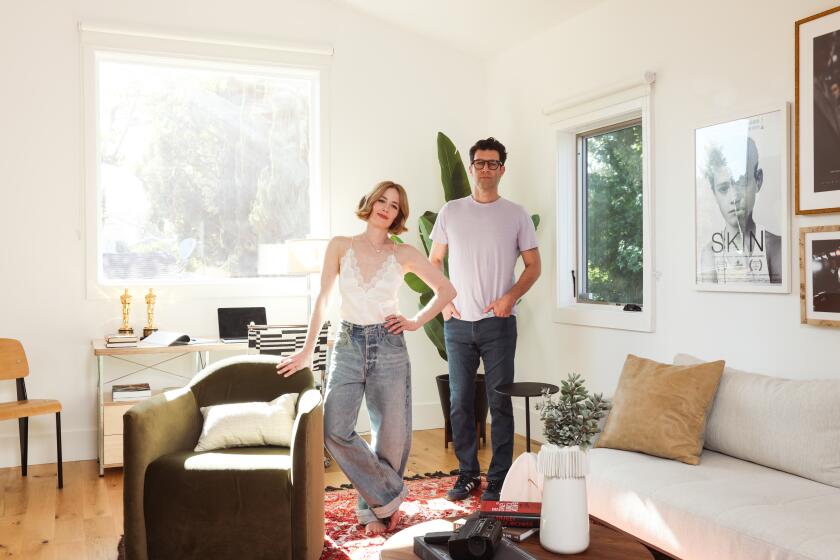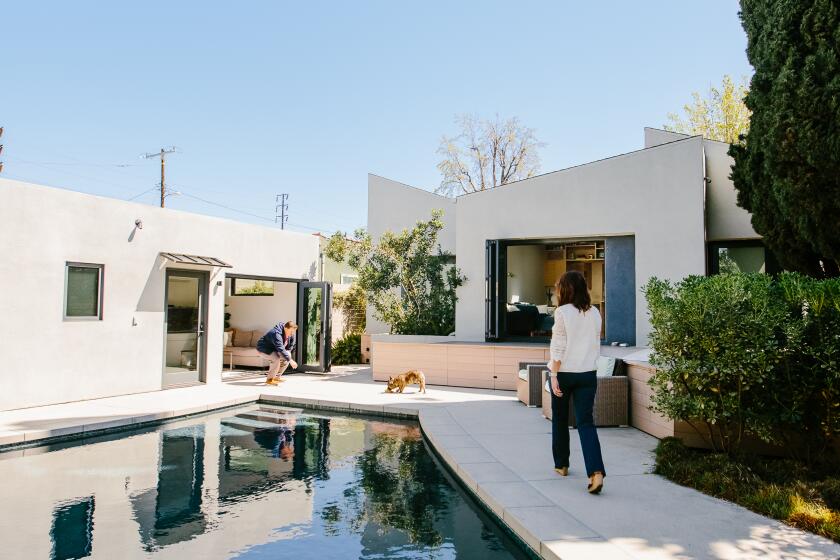Home tells tales of family’s dream
The vintage two-story house is missing a few porch planks, and plaster is slumping off in chunks, succumbing to the unyielding Riverside heat.
Hidden in the overgrown front lawn, however, are two national historic landmark plaques. The home was once owned by the Harada family, victors in an early 20th-century equal-rights battle that challenged state laws barring Asian immigrants from owning property.
“There’s nothing architecturally distinctive about the house,” said Riverside Mayor Ron Loveridge. “What’s important is the story told by the people who lived there.”
Today, the plain, two-story house is largely void of furniture. The rooms are scattered with construction hats and wooden supports, rain-damaged walls and concrete pillars.
The city of Riverside, which took ownership of the house three years ago, is restoring the house and turning it into a civil-rights museum and education center for area schools beginning in the fall.
“The family is representative of the Japanese Americans of the 20th century,” said Lynn Voorheis, curator of historic structures and collections at the Riverside Metropolitan Museum. “The lawsuit was a landmark and emblematic of the American dream.”
Jukichi and Ken Harada bought the home in 1915. Jukichi Harada put the title in the name of his three American-born children. The law prevented Japanese natives from owning property.
The Haradas operated a popular cafe called the Washington Restaurant in downtown Riverside, an homage to Jukichi Harada’s hero George Washington. He hung portraits of every U.S. president on its walls.
But residents of the white-collar neighborhood formed a committee to buy out the Haradas to move them out of the area.
When the Haradas refused to move, 60 families signed a petition calling for the family’s eviction.
The California attorney general’s office filed suit to seize the Harada home, alleging the family had violated the California Alien Land Law.
The state contended the home was purchased in the children’s names to bypass the law.
But Riverside County Superior Court Judge Hugh Craig in 1918 ruled that the three children could legally own the house based on the children’s rights as citizens under the 14th Amendment.
“As American citizens they are entitled to equal protection under the law, the same as anyone else, no matter what their parentage,” Craig said in his ruling.
The state did not appeal the decision, allowing others to own land by putting it in their U.S.-born children’s names.
The judge also ruled that the Alien Land Law was constitutional. It wasn’t overturned until after World War II.
For the next two decades, the family lived quietly in the Lemon Street home, adding a second story to accommodate a growing family, which included six children.
Jukichi Harada kept reapplying for citizenship, knowing his application would be rejected.
The family’s life was again interrupted after the attack on Pearl Harbor in 1941, when President Franklin D. Roosevelt signed an executive order to have all people of Japanese descent placed in internment camps.
Before leaving, one of the Haradas’ sons, Harold, scribbled on his bedroom wall: “Evacuated on May 23, 1942. Sat. 7 AM.”
Initially, the Harada family was placed in three camps: Tule Lake, Calif.; Poston, Ariz.; and Topaz, Utah. Harold, Sumi and Roy Harada petitioned to join their parents at the Topaz camp. The request was eventually granted.
Jukichi and Ken Harada died of natural causes while under internment.
But thanks to Jess Stebler, a family friend caring for the house during the deployment, their daughter, Sumi Harada, returned to it in 1945.
She opened it to other families returning from internment. Many nights, they would sleep in every one of the 13 tiny rooms.
Over the next four decades, she became a guardian of the house, protecting its trove of photographs, documents, newspapers and journals in memory of her pioneering parents.
In a letter at the ceremony designating the site a national historic landmark in 1990, President George H.W. Bush wrote a letter to her stating, “We can never fully right wrongs of the past,” and he apologized for the family being sent to the relocation camp.
When Sumi died in 2000, Harold Harada inherited the home. He continued conversations with Riverside officials that Sumi had had regarding donating the home to the city. After he died, the city took stewardship in 2004.
“They wanted it to be the face of a bigger immigration story,” said Ennette Nusbaum, the Riverside museum’s director. “Ultimately, it’s a place for people to learn history and to actually see it.”
On a recent afternoon, the inside of the house is sweltering. Rains from two years ago turned chips in a wall into large cracks. And at points, one has to duck down to avoid bumping wooden support structures.
“It’s a work in progress,” Nusbaum said.
But traces of its significance still catch the eye.
Harold’s message is still there on the wall, in fading pencil. A 1942 calendar hangs on another wall. And the museum is already displaying vintage Japanese kimonos found tucked away in the house.
“I see it as a story of what happens to people who are immigrants who come to this country and the kinds of discriminations and prejudice that they are faced with,” said Naomi Harada, Sumi’s niece.
“In a lot of ways it’s unbelievable that people can get through all that and still succeed,” Harada said.
The house still needs seismic stabilization and site drainage. But officials hope it will soon be a showcase of one American family’s civil rights triumph.
“The house itself tells the story,” Mayor Loveridge said.
“It helps us show the distance of how far we’ve come since then.”
--
More to Read
Sign up for Essential California
The most important California stories and recommendations in your inbox every morning.
You may occasionally receive promotional content from the Los Angeles Times.









